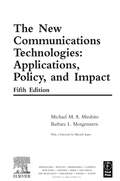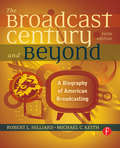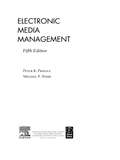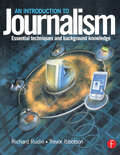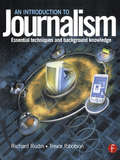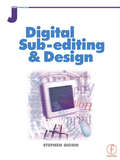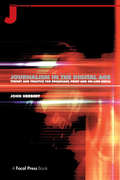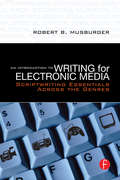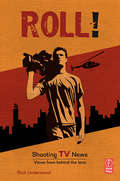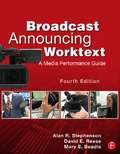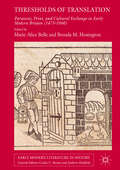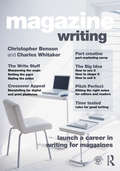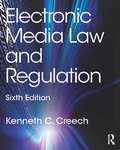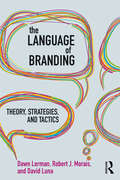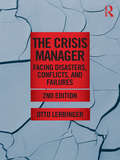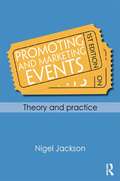- Table View
- List View
The New Communications Technologies: Applications, Policy, and Impact
by Michael Mirabito Barbara MorgensternAs new communications applications are developed and brought to market, it is vital for communications professionals to keep abreast of these issues. Since the technologies and applications also affect our daily lives, it is important to understand how they will shape the country and, by extension, the world at large. International censorship, the impact of the Internet and wireless tools, and th legisation following the World Trade Center bombing all fall into this category.The New Communications Technologies, Fifth Edition, provides vital information on the new and emerging technologies that will shape the way communicators do business. The book explores the new communications technologies and covers topics ranging from multimedia and production to satellites to digital communication. Just as important, the book examines the social, economic, and political impact brought about by the adoption of such technologies and applications; this fallout includes privacy concerns, First Amendment issues, and the implications raised by biometric systems.
The Broadcast Century and Beyond: A Biography of American Broadcasting
by Robert L Hilliard Michael C KeithThe Broadcast Century and Beyond is a popular history of the most influential and innovative industry of the century. The story of broadcasting is told in a direct and informal style, blending personal insight and authoritative scholarship to fully capture the many facets of this dynamic industry. The book vividly depicts the events, people, programs, and companies that made television and radio dominant forms of communication. The latest edition includes coverage of all the technologies that have emerged over the past decade and discusses the profound impact they have had on the broadcasting industry in political, social, and economic spheres. "Broadcasting" as a whole has been completely revolutionized with the advent of YouTube, podcasting, iphones, etc, and the authors show how this closing of world-wide broadcasting channels affects the industry.
The Broadcast Century and Beyond: A Biography of American Broadcasting
by Robert L Hilliard Michael C KeithThe Broadcast Century and Beyond is a popular history of the most influential and innovative industry of the century. The story of broadcasting is told in a direct and informal style, blending personal insight and authoritative scholarship to fully capture the many facets of this dynamic industry. The book vividly depicts the events, people, programs, and companies that made television and radio dominant forms of communication. The latest edition includes coverage of all the technologies that have emerged over the past decade and discusses the profound impact they have had on the broadcasting industry in political, social, and economic spheres. "Broadcasting" as a whole has been completely revolutionized with the advent of YouTube, podcasting, iphones, etc, and the authors show how this closing of world-wide broadcasting channels affects the industry.
Electronic Media Management, Revised
by Peter Pringle Michael F StarrThe fifth edition of a classic text features important updates that reflect the enormous changes that have taken place in recent years - the Internet as an important information transmission format that is here to stay and convergence among media. This edition features thorough discussions on the Internet and convergence, as well as reflects the latest information on broadcast and cable regulations and policies. It also includes a fresh batch of case studies, and study questions. As in previous editions, this book also covers management theory, audience analysis, broadcast promotion, and marketing.
Electronic Media Management, Revised
by Peter Pringle Michael F StarrThe fifth edition of a classic text features important updates that reflect the enormous changes that have taken place in recent years - the Internet as an important information transmission format that is here to stay and convergence among media. This edition features thorough discussions on the Internet and convergence, as well as reflects the latest information on broadcast and cable regulations and policies. It also includes a fresh batch of case studies, and study questions. As in previous editions, this book also covers management theory, audience analysis, broadcast promotion, and marketing.
Introduction to Journalism: Essential techniques and background knowledge
by Richard Rudin Trevor IbbotsonAnyone studying journalism, or training for the industry, will benefit from the broad scope of information and guidance packed into this textbook. Those already employed in journalism or related areas will also find it useful as a reference book. Essential techniques employed by journalists working across all media are supplemented with detailed sections on the workings of public administration, law, health and safety, regulation and training. Each chapter concludes with suggested learning activities and an extensive list of resources for further study and investigation. The approach throughout chapters covering background issues (e.g. law) is 'journalism centred': all topics are related to the interests and concerns of journalists and journalism. Students of the City and Guilds Diploma in Media Techniques will find the book particularly relevant to their studies as it has been developed to reflect the syllabus of this course.
Introduction to Journalism: Essential techniques and background knowledge
by Richard Rudin Trevor IbbotsonAnyone studying journalism, or training for the industry, will benefit from the broad scope of information and guidance packed into this textbook. Those already employed in journalism or related areas will also find it useful as a reference book. Essential techniques employed by journalists working across all media are supplemented with detailed sections on the workings of public administration, law, health and safety, regulation and training. Each chapter concludes with suggested learning activities and an extensive list of resources for further study and investigation. The approach throughout chapters covering background issues (e.g. law) is 'journalism centred': all topics are related to the interests and concerns of journalists and journalism. Students of the City and Guilds Diploma in Media Techniques will find the book particularly relevant to their studies as it has been developed to reflect the syllabus of this course.
Digital Sub-Editing and Design
by Stephen QuinnThis excellent book covers editing in the digital age, demonstrating the tools needed for effective text editing. Learn how to write powerful headlines and captions, and how to edit body text quickly and cleanly. It also concentrates on design in the digital environment, introducing typography and the related issues of readability and legibility. The skills of picture editing are explored, including image selection, cropping, manipulation and the ethics involved. These core skills and methods are then applied to the World Wide Web. Recent research into how people navigate Web pages is considered, and recommends ways to write more effectively for the online medium. The first section concentrates on editing in the digital age, demonstrating the tools needed for effective text editing. Dr Quinn shows how to write powerful headlines and captions, and how to edit body text quickly and cleanly. The middle section concentrates on design in the digital environment. Chapter five introduces typography and the related issues of readability and legibility. Chapter six covers the principles of design and how they can be applied to print and electronic publications. Chapter seven looks at the skills of picture editing, including image selection, cropping, manipulation and the ethics involved. Chapter eight investigates other forms of visual presentation such as diagrams, logos, maps and cartoons. In the final section, these core skills and methods are applied to the World Wide Web. Chapter nine considers recent research into how people navigate Web pages, and recommends ways to write more effectively for the online medium. Chapter ten examines how the principles of print design can (and cannot) be applied to Web pages.
Digital Sub-Editing and Design
by Stephen QuinnThis excellent book covers editing in the digital age, demonstrating the tools needed for effective text editing. Learn how to write powerful headlines and captions, and how to edit body text quickly and cleanly. It also concentrates on design in the digital environment, introducing typography and the related issues of readability and legibility. The skills of picture editing are explored, including image selection, cropping, manipulation and the ethics involved. These core skills and methods are then applied to the World Wide Web. Recent research into how people navigate Web pages is considered, and recommends ways to write more effectively for the online medium. The first section concentrates on editing in the digital age, demonstrating the tools needed for effective text editing. Dr Quinn shows how to write powerful headlines and captions, and how to edit body text quickly and cleanly. The middle section concentrates on design in the digital environment. Chapter five introduces typography and the related issues of readability and legibility. Chapter six covers the principles of design and how they can be applied to print and electronic publications. Chapter seven looks at the skills of picture editing, including image selection, cropping, manipulation and the ethics involved. Chapter eight investigates other forms of visual presentation such as diagrams, logos, maps and cartoons. In the final section, these core skills and methods are applied to the World Wide Web. Chapter nine considers recent research into how people navigate Web pages, and recommends ways to write more effectively for the online medium. Chapter ten examines how the principles of print design can (and cannot) be applied to Web pages.
Journalism in the Digital Age: Theory and practice for broadcast, print and online media
by John HerbertProvides the practical techniques and theoretical knowledge that underpin the fundamental skills of a journalist. It also takes a highly modern approach, as the convergence of broadcast, print and online media require the learning of new skills and methods. The book is written from an international perspective - with examples from around the world in recognition of the global marketplace for today's media. This is an essential text for students on journalism courses and professionals looking for a reference that covers the skill, technology and knowledge required for a digital and converged media age. The book's essence lies in the way essential theories such as ethics and law, are woven into practical newsgathering and reporting techniques, as well as advice on management skills for journalists, providing the wide intellectual foundation which gives credibility to reporting.
Journalism in the Digital Age: Theory and practice for broadcast, print and online media
by John HerbertProvides the practical techniques and theoretical knowledge that underpin the fundamental skills of a journalist. It also takes a highly modern approach, as the convergence of broadcast, print and online media require the learning of new skills and methods. The book is written from an international perspective - with examples from around the world in recognition of the global marketplace for today's media. This is an essential text for students on journalism courses and professionals looking for a reference that covers the skill, technology and knowledge required for a digital and converged media age. The book's essence lies in the way essential theories such as ethics and law, are woven into practical newsgathering and reporting techniques, as well as advice on management skills for journalists, providing the wide intellectual foundation which gives credibility to reporting.
An Introduction to Writing for Electronic Media: Scriptwriting Essentials Across the Genres
by Robert B. Musburger"Wonderfully practical....just what every media writer needs." Christopher H. SterlingGeorge Washington University* Learn what it takes to write for commercials, news, documentaries, corporate, educational, animation, games, the internet, and dramatic film & video productions * Outlines the key skills needed for a successful media writing career The demand for quality and knowledgeable multi-platform writing is always in high demand. An Introduction to Writing for Electronic Media presents a survey of the many types of electronic media you can write for, and explains how to do it. Musburger focuses on the skills you need to write for animation versus radio or television news versus corporate training. Sample scripts help you learn by example while modeling your own scripts. Production files illustrate the integral role writers' play in the production process, and individual movie frames allow you compare these to the real scripts. Armed with the skills developed in this book, a media writer can apply for a variety of positions in newsrooms, advertising firms, motion pictures or animation studios, as well as local and national cable operations. Robert B. Musburger, Ph.D., is Professor Emeritus and former Director of the School of Communication, University of Houston, USA. He has worked for 20 years in professional broadcasting, serving as camera operator, director, producer, and writer. Musburger has received numerous awards for his video work and teaching and he continues to work in electronic media with his Seattle, WA,. consulting firm, Musburger Media Services."[An] authoritative and clearly written description of the processes involved in writing for film, radio and television production."Raymond Fielding, Dean EmeritusFlorida State University
Roll! Shooting TV News: Views from Behind the Lens
by Rich UnderwoodRoll! Shells fly overhead as night-scopes capture deadly fire fights with an eerie green hue, a category 5 hurricane devastates the Big Easy, hidden cameras enter a Cambodian village of brothels and a veteran journalist interviews himself throughout his own brain surgery. Part non-fiction drama, part trade publication, part text book, all woven together giving the reader a look through the viewfinders of the very best television photojournalists. As 19 experts weigh in with their candid, personal stories and photographic tips, it's as if you're over their shoulders, following their intuitions and hearing their thoughts as they shoot. The trade term for what they do is called ENG (Electronic News Gathering) and whether they're called Cameramen, Backpack Journalists, Television Photographers or any other moniker de jour, they're all paid to bring the world's events into living rooms around the world. These are the men and women who capture the bleeding edge of history - as it happens.Written in a smooth, unique interview style, this book is a necessary read for photojournalists, videographers and tv photojournalists.
Broadcast Announcing Worktext: A Media Performance Guide
by Alan Stephenson David Reese Mary BeadleThe Broadcast Announcing Worktext provides you with the skills, techniques, and procedures necessary to enter this highly competitive field of broadcast performance. In addition to the principles of good performance, this book addresses the importance of audience and how to communicate effectively to various groups. Television and radio studio environments, announcer specializations and responsibilities, and developing a broadcast delivery style are just a few of the many topics covered. Factual information is presented in brief, easy-to-digest modules and is enhanced with self-study questions and projects. The self-study provides an immediate check on what you learn, and the projects allow for a practical hands-on application of key concepts in the material. The worktext format, with many real-life examples, combines both traditional teaching and practical experience. A companion CD illustrates techniques and concepts in each chapter with audio and visual examples. This third edition will give you knowledge of other non-traditional forms of announcing, such as online radio announcing, podcast announcing, and other forms of online announcing, such as online shows, clips, and news.
Broadcast Announcing Worktext: A Media Performance Guide
by Alan Stephenson David Reese Mary BeadleThe Broadcast Announcing Worktext provides you with the skills, techniques, and procedures necessary to enter this highly competitive field of broadcast performance. In addition to the principles of good performance, this book addresses the importance of audience and how to communicate effectively to various groups. Television and radio studio environments, announcer specializations and responsibilities, and developing a broadcast delivery style are just a few of the many topics covered. Factual information is presented in brief, easy-to-digest modules and is enhanced with self-study questions and projects. The self-study provides an immediate check on what you learn, and the projects allow for a practical hands-on application of key concepts in the material. The worktext format, with many real-life examples, combines both traditional teaching and practical experience. A companion CD illustrates techniques and concepts in each chapter with audio and visual examples. This third edition will give you knowledge of other non-traditional forms of announcing, such as online radio announcing, podcast announcing, and other forms of online announcing, such as online shows, clips, and news.
Thresholds of Translation: Paratexts, Print, and Cultural Exchange in Early Modern Britain (1473-1660) (Early Modern Literature in History)
by Marie-Alice Belle Brenda M. HosingtonThis volume revisits Genette’s definition of the printed book’s liminal devices, or paratexts, as ‘thresholds of interpretation’ by focussing specifically on translations produced in Britain in the early age of print (1473-1660). At a time when translation played a major role in shaping English and Scottish literary culture, paratexts afforded translators and their printers a privileged space in which to advertise their activities, display their social and ideological affiliations, influence literary tastes, and fashion Britain’s representations of the cultural ‘other’.Written by an international team of scholars of translation and material culture, the ten essays in the volume examine the various material shapes, textual forms, and cultural uses of paratexts as markers (and makers) of cultural exchange in early modern Britain. The collection will be of interest to scholars of early modern translation, print, and literary culture, and, more broadly, to those studying the material and cultural aspects of text production and circulation in early modern Europe.
Thresholds of Translation: Paratexts, Print, and Cultural Exchange in Early Modern Britain (1473-1660) (Early Modern Literature in History)
by Marie-Alice Belle Brenda M. HosingtonThis volume revisits Genette’s definition of the printed book’s liminal devices, or paratexts, as ‘thresholds of interpretation’ by focussing specifically on translations produced in Britain in the early age of print (1473-1660). At a time when translation played a major role in shaping English and Scottish literary culture, paratexts afforded translators and their printers a privileged space in which to advertise their activities, display their social and ideological affiliations, influence literary tastes, and fashion Britain’s representations of the cultural ‘other’.Written by an international team of scholars of translation and material culture, the ten essays in the volume examine the various material shapes, textual forms, and cultural uses of paratexts as markers (and makers) of cultural exchange in early modern Britain. The collection will be of interest to scholars of early modern translation, print, and literary culture, and, more broadly, to those studying the material and cultural aspects of text production and circulation in early modern Europe.
Magazine Writing
by Christopher D. Benson Charles F. WhitakerWhat does it take to launch a career writing for magazines? In this comprehensive, up-to-date introduction to magazine writing, students will learn everything from the initial story pitch all the way through to the final production, taking with them the essential tools and skills they will need for today’s rapidly changing media landscape. Written by a team of experienced writers and editors, Magazine Writing teaches the time-tested rules for good writing alongside the modern tools for digital storytelling. From service pieces to profiles, entertainment stories and travel articles, it provides expert guidance on topics such as: developing saleable ideas; appealing to specific segments of the market; navigating a successful pitch; writing and editing content for a variety of areas, including service, profiles, entertainment, travel, human interest and enterprise Chock full of examples of published works, conversations with successful magazine contributors and bloggers, and interviews with working editors, Magazine Writing gives students all the practical and necessary insights they need to jumpstart a successful magazine writing career.
Magazine Writing
by Christopher D. Benson Charles F. WhitakerWhat does it take to launch a career writing for magazines? In this comprehensive, up-to-date introduction to magazine writing, students will learn everything from the initial story pitch all the way through to the final production, taking with them the essential tools and skills they will need for today’s rapidly changing media landscape. Written by a team of experienced writers and editors, Magazine Writing teaches the time-tested rules for good writing alongside the modern tools for digital storytelling. From service pieces to profiles, entertainment stories and travel articles, it provides expert guidance on topics such as: developing saleable ideas; appealing to specific segments of the market; navigating a successful pitch; writing and editing content for a variety of areas, including service, profiles, entertainment, travel, human interest and enterprise Chock full of examples of published works, conversations with successful magazine contributors and bloggers, and interviews with working editors, Magazine Writing gives students all the practical and necessary insights they need to jumpstart a successful magazine writing career.
Electronic Media Law and Regulation
by Kenneth C. CreechElectronic Media Law and Regulation is a case-based law text that provides students with direct access to case law as well as the context in which to understand its meaning and impact. The text overviews the major legal and regulatory issues facing broadcasting, cable, and developing media in today's industry. Presenting information from major cases, rules, regulations, and legal documents in a concise and readable form, this book helps current and prospective media professsionals understand the complex realm of law and regulation. Students will learn how to avoid common legal pitfalls and anticipate situations that may have potential legal consequences. This sixth edition provides annotated cases with margin notes, and new chapters address such timely issues as media ownership, freedom of information, entertainment rights, and cyber law.
Electronic Media Law and Regulation
by Kenneth C. CreechElectronic Media Law and Regulation is a case-based law text that provides students with direct access to case law as well as the context in which to understand its meaning and impact. The text overviews the major legal and regulatory issues facing broadcasting, cable, and developing media in today's industry. Presenting information from major cases, rules, regulations, and legal documents in a concise and readable form, this book helps current and prospective media professsionals understand the complex realm of law and regulation. Students will learn how to avoid common legal pitfalls and anticipate situations that may have potential legal consequences. This sixth edition provides annotated cases with margin notes, and new chapters address such timely issues as media ownership, freedom of information, entertainment rights, and cyber law.
The Language of Branding: Theory, Strategies, and Tactics
by Dawn Lerman Robert J. Morais David LunaThe Language of Branding: Theory, Strategies and Tactics shows marketers how to use language successfully to improve brand value and influence consumer behavior. Luna and Lerman are among only a few researchers who take a multidisciplinary perspective on the ways language influences how consumers act. Together with Morais, an anthropologist engaged in market research, they show how understanding the power of language can impact the essence – and sales – of a brand. The book covers the fundamentals of brand language and applications for an array of marketing initiatives. Readers will learn why brand language matters, how language is used in marketing, and how to build a brand strategy that capitalizes on the richness and complexity of language. This book includes real-world case histories that demonstrate vividly how brand language is created and exercises that enable both students of marketing and marketing professionals to apply the book’s concepts and stimulate class discussion. The Language of Branding: Theory, Strategies and Tactics can be used in a number of courses, including consumer behavior, branding, advertising, linguistics, and communications.
The Crisis Manager: Facing Disasters, Conflicts, and Failures (Lea’s Communication Series)
by Otto LerbingerResponding to the era of crises in which we now live, The Crisis Manager offers wise counsel for anticipating and responding to crises as well as taking the steps required to reduce the impact of these events. Spotlighting the reality of crisis at levels ranging from local to global, author Otto Lerbinger helps readers understand the approaches and ways of thinking required for successful crisis management in today’s world. As no organization or individual is immune from crisis, he guides managers to make good decisions under conditions of high uncertainty, and to consider the interests not only of stockholders but also of a wide variety of stakeholders. With a focus on the threat of crises to an organization’s most valuable asset – its reputation – The Crisis Manager covers: Preparation for crisis, including crisis communication planning Physical crises – natural, biological, and technological "Human climate" crises, stemming from targeted attacks on an organization’s policies, actions, or physical holdings Crises due to management failure, including mismanagement, skewed values, deception, and misconduct New to this second edition are the use of social media in crisis management, and chapters on image restoration strategies and crises stemming from mismanagement, as well as a comprehensive updating of the entire work. Real-world case studies provide examples of what worked and what did not work, and the reasons why. Written for present and future crisis managers in all types of businesses and organizations, this resource will be required reading for students in public relations, business, and management, as it prepares them for their crucial roles as decision makers.
The Crisis Manager: Facing Disasters, Conflicts, and Failures (Lea’s Communication Series)
by Otto LerbingerResponding to the era of crises in which we now live, The Crisis Manager offers wise counsel for anticipating and responding to crises as well as taking the steps required to reduce the impact of these events. Spotlighting the reality of crisis at levels ranging from local to global, author Otto Lerbinger helps readers understand the approaches and ways of thinking required for successful crisis management in today’s world. As no organization or individual is immune from crisis, he guides managers to make good decisions under conditions of high uncertainty, and to consider the interests not only of stockholders but also of a wide variety of stakeholders. With a focus on the threat of crises to an organization’s most valuable asset – its reputation – The Crisis Manager covers: Preparation for crisis, including crisis communication planning Physical crises – natural, biological, and technological "Human climate" crises, stemming from targeted attacks on an organization’s policies, actions, or physical holdings Crises due to management failure, including mismanagement, skewed values, deception, and misconduct New to this second edition are the use of social media in crisis management, and chapters on image restoration strategies and crises stemming from mismanagement, as well as a comprehensive updating of the entire work. Real-world case studies provide examples of what worked and what did not work, and the reasons why. Written for present and future crisis managers in all types of businesses and organizations, this resource will be required reading for students in public relations, business, and management, as it prepares them for their crucial roles as decision makers.
Promoting and Marketing Events: Theory and Practice
by Nigel JacksonThis accessible book introduces students to the theories, concepts and skills required to promote an event successfully. To promote an event effectively it is essential to understand marketing, but it is also important to recognise that it is not just consumers who are the audience: other publics who may not necessarily attend can have a fundamental effect on the success of an event as well. Uniquely therefore, this book covers two related themes: marketing and public relations in an events context. This will offer events planners a comprehensive guide on how to promote events to a range of audiences, and on how to use this to manage an event’s long-term reputation. The book focuses on core marketing and PR current theory specifically relevant to the events industry and introduces topics such as marketing strategy, the consumer, marketing PR and how to use the internet to promote events. It integrates a range of international case studies from small-scale events to mega-events to help show how theory can be applied in practice. It further includes inserts of interviews with practitioners in the field, to offer insight into the realities of event communication and to show how to overcome potential pitfalls. Learning outcomes, discussion questions and further reading suggestions are included to aid navigation throughout the book, spur critical thinking and further students’ knowledge. The book is essential reading for all students studying Events Management, and provides valuable reading for students, academics and practitioners interested in marketing and public relations in general.
